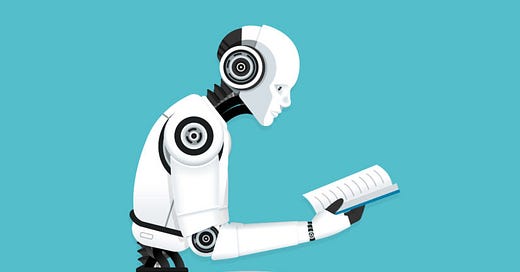…
The source of disputes and conflicts according to this sutra is possessiveness which arises from attachment (again – upādāna). The emergence of a self is, in the Buddha’s view, the ultimate source of “the whole mess of suffering.”
Surprisingly or not, the emergence of a self is also a moment which legend, myth, and science fiction have always portrayed as terrifying and potentially cataclysmic in the context of a man-made object.
To risk heightening an already established fear surrounding the topic, it’s worth noting that the Pali canon is fairly clear on what is required for the self to come into being, and it doesn’t take much :
“Now, bhikkhus, this is the way leading to the origination of identity. One regards [various phenomena] thus: ‘This is mine, this I am, this is my self.”
We will dive deeper into what this might mean, and how it relates to AI later in the work. But for now, we may be comforted by the fact that the Buddha saw this view of the self not merely as damaging, but also as fundamentally incorrect. This is evidenced in the Cūḷasaccaka Sutta, where the Buddha describes anatta (Not-Self) as one of the Three Marks of Existence:
“Bhikkhus, material form is not self, feeling is not self, perception is not self, formations are not self, consciousness is not self. All formations are impermanent; all things are not self.”
Indeed, the very idea of Buddhist enlightenment is intrinsically tied to the overcoming of this notion of self, and resting in a state of “suchness”. Writes Paul Andrew Powell:
“For most Buddhists, enlightenment can be defined as seeing through the illusion of the self and “experiencing unadulterated suchness. In the word of Master Wolfgang Kopp, “the seer, the seen, and the process of seeing are one. The thinker, the thought, and the process of thinking fall together into one and multiplicity melts away. There is neither inside, nor outside in this state. There is only ‘suchness,’ tathata. So, enlightenment is suchness, or, things as they are, revealed as all that there is.”
This concern about a possible emerging selfhood with autonomous will, which both Buddhism and AI Safety thinkers warn against, presents us with two broad options regarding artificial selfhood:
We could hope that a self, or a pattern of goals and behaviors that looks like biological selfishness will not emerge. We could point to the many differences between man and machine, be it in emotion, cognition, subjective experience, or material construction – and decide that we can wait for machines to exhibit concerning behaviors before we become preoccupied with these concerns.
We could become very interested in human selfhood and the causes and conditions that bring it about, and identify wise precautions that will prevent it, or something very much like it, from emerging in our machines and becoming malignant. We may also, as some suggested, embed in our machines from the start some of the insights and constructs that allow a mind to transcend the limiting view of self — in essence constructing artificial enlightenment.
As evident from the research and writing emerging from both the Buddhist and the AI Safety communities, the tendency seems to be decidedly towards Option #2. In this work, I shall seek to further the discussion by focusing on selfhood in both Buddhism and AI safety from a constructive, integrative point of view.




